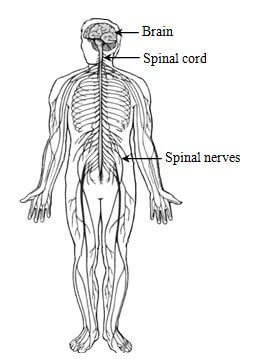 The nervous system can be divided into three main divisions:
The nervous system can be divided into three main divisions:
- The central nervous system (CNS)
- The peripheral nervous system (PNS)
- The autonomic nervous system (ANS)
Central Nervous System
The central nervous system consists of brain and spinal cord.
Peripheral Nervous System
The peripheral nervous system consists of nerves arising from the brain and spinal cord. The nerves that originate from the brain are called cranial nerves, and the nerves that originate from the spinal cord are called spinal nerves.
Autonomic Nervous System
Autonomic nervous system is a special system which controls and coordinates those activities of body that which are not under the control of will (involuntary organs). So, autonomic nervous system controls and coordinates those activities of body which do not require thinking such as beating of heart, secretions of glands, blinking of eyes and sneezing. It is further divided into sympathetic and parasympathetic nervous system.
The functions of sympathetic and parasympathetic nervous system are opposite to each other. For example, the sympathetic nervous system increases the heart beat whereas the parasympathetic nervous system decreases the heart beat. In the same way, the sympathetic nervous system constricts the arteries and raises blood pressure whereas the parasympathetic nervous system dilates arteries and lowers blood pressure.
Test Your Understanding and Answer These Questions:
- Expand PNS and CNS.
- What is autonomic nervous system?
- Give differences between sympathetic and parasympathetic nervous system.
